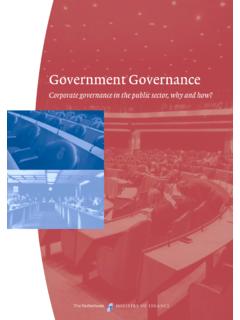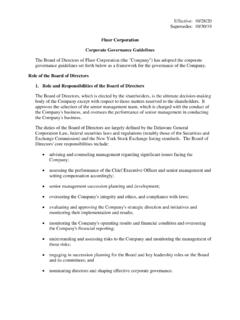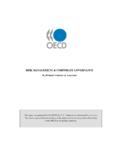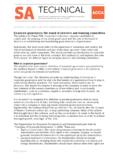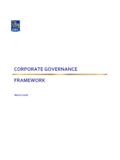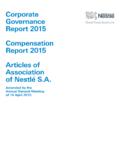Transcription of Chapter 6. Corporate Governance - OECD.org
1 OECD 2011. A publication of the Investment Division of the OECD Directorate for Financial and Enterprise Affairs. OECD freely authorises the use of this material for non-commercial purposes. All requests for commercial use or translation of this material should be submitted to This work is published on the responsibility of the Secretary-General of the OECD. The opinions expressed and arguments employed herein do not necessarily reflect the official views of the Organisation or of the governments of its member countries. This document and any map included herein are without prejudice to the status of or sovereignty over any territory, to the delimitation of international frontiers and boundaries and to the name of any territory, city or area.
2 POLICY FRAMEWORK FOR INVESTMENT USER S TOOLKIT Chapter 6. Corporate Governance Introductory note The PFI User s Toolkit project responds to a need for specific and practical implementation guidance revealed from the experience of the countries that have already used or plan to use the PFI. Development of the Toolkit has entailed a process, involving government users, co-operation with other organisations, OECD Committees with specialised expertise in the policy areas covered by the PFI and interested stakeholders. Against this background, this document offers guidance relating to the Corporate Governance Chapter of the PFI.
3 The PFI User s Toolkit is purposely structured in a way that is amenable to producing a web-based publication. A web-based format allows: a flexible approach to providing updates and additions; PFI users to download the guidance only relevant to the specific PFI application being implemented; and a portal offering users more detailed resources and guidance on each PFI question. The website is accessible at 2 Corporate Governance Corporate Governance reform is an important aspect of broader reforms aimed at securing an environment attractive to both domestic and foreign investors and that enhances the benefits of investment to society.
4 As the Preamble to the OECD Principles of Corporate Governance states, The degree to which corporations observe basic principles of good Corporate Governance is an increasingly important factor for investment decisions. Of particular relevance is the relation between Corporate Governance practices and the increasingly international character of investment. International flows of capital enable companies to access financing from a much larger pool of investors. If countries are to reap the full benefits of the global capital market, and if they are to attract long-term patient capital, Corporate Governance arrangements must be credible, well understood across borders and adhere to internationally accepted principles.
5 Even if corporations do not rely primarily on foreign sources of capital, adhering to good Corporate Governance practices will help improve the confidence of domestic investors, reduce the cost of capital, underpin the good functioning of financial markets, and ultimately induce more stable sources of financing. It is not only the absolute amount of available capital that will determine the ability to increase economic welfare through capital formation. Equally important is the effectiveness with which it is allocated among alternative investment opportunities and, not least, how well the corporation s final use of it is actually monitored.
6 If household savings and available Corporate funds do not reach their best possible use, society will forgo opportunities that would have generated additional economic welfare. Under such circumstances, entrepreneurs will not find appropriate funding for profitable projects, existing companies will not be able to expand their operations, and potentially profitable innovations will never be commercialised. Moreover, necessary re-structuring of individual companies and entire industries will be impaired, and productive assets will be locked into underperforming activities.
7 The 9 PFI questions on Corporate Governance relate to: Legal, regulatory and institutional framework Equitable treatment Protecting shareholder rights Shareholder influence Disclosure The role of the board and the rights of stakeholders Voluntary private initiatives National reviews State-owned enterprises These questions provide a brief introduction to some of the key Corporate Governance issues that policymakers and others should address to promote a sounder environment for investment. For a more complete assessment, policymakers should turn to the OECD Principles of Corporate Governance and its assessment methodology, or visit 3 Legal, regulatory and institutional framework What steps have been taken to ensure the basis for a Corporate Governance framework that promotes overall economic performance and transparent and efficient markets?
8 Has this been translated into a coherent and consistent regulatory framework, backed by effective enforcement? Key considerations An effective Corporate Governance framework requires a sound legal, regulatory and institutional foundation, upon which all market participants can rely when they enter into contractual relations. This framework typically comprises elements of legislation, regulation, self-regulatory arrangements, voluntary commitments and business practices, with the balance among them determined by a country s specific economic circumstances, history and traditions.
9 The framework is also dynamic: as new experiences accrue and business circumstances change, the content and structure might need to be adjusted. In this process, it is essential to assess the quality of the domestic framework in light of international developments and requirements. The Corporate form of organisation of economic activity is a powerful force for growth. The regulatory and legal environment in which corporations operate is therefore crucial for overall economic outcomes. Policymakers have a responsibility to put in place a framework that is flexible enough to meet the needs of corporations operating in widely different circumstances, facilitating their development of new opportunities to create value and to determine the most efficient deployment of resources.
10 This requires a focus on the ultimate economic outcomes from interventions. When considering different policy options, it is also useful to undertake an analysis of how key variables affect the functioning of markets, such as incentive structures, the efficiency of self-regulatory systems and the way systemic conflicts of interest are dealt with. Corporate Governance requirements and practices are typically influenced by an array of legal domains, such as company law, securities regulation, accounting and auditing standards, insolvency law, contract law, labour law and tax law.










